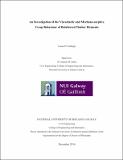| dc.description.abstract | The reinforcement of timber using fibre reinforced polymer (FRP) rods or plates is widely accepted as an effective method of increasing the strength and stiffness of members. Across Europe, this technology has been used, not only in new structures, but in the upgrading and repair of existing structures. When retrofitting these structures, changes in use of the building or, indeed, changes in building regulations often require a higher load capacity than that of the existing members. The additional capacity requirements can be successfully achieved in a timely and cost-effective manner through the use of FRP reinforcement. More widespread use of this technology has been hampered by the lack of a harmonised standard governing their design. Currently, design rules for FRP reinforcement are not included in Eurocode 5, which is the European standard governing the design of timber structures. The reasons for this are partly due to a lack of knowledge, particularly related to the long-term performance.
This body of research aims to help researchers and design engineers to better understand the long-term or creep performance of FRP reinforced timber elements and to contribute to the development of design approaches, which account for the influence of reinforcement on this behaviour. This requires an examination of the main mechanical responses that are commonly observed in timber members under long-term loading, namely, the elastic, viscoelastic, mechano-sorptive and swelling/shrinkage responses. An experimental programme was designed to identify and characterise these individual responses on matched groups of glued laminated beams having statistically equal bending stiffness. This experimental programme involved the simultaneous loading of an equal proportion of unreinforced and reinforced beams to a common bending stress on the compression face in constant and variable climates for a period of 75 weeks. In the constant climate condition, the unreinforced and reinforced beams were subject to elastic and viscoelastic creep behaviour. In the variable climate condition, the beams were subject to elastic and viscoelastic creep behaviour and also, as a result of the variable climate condition, were subject to hygro-mechanical behaviour, which includes mechano-sorptive and swelling/shrinkage behaviour. The mid-span vertical deflection and longitudinal strain on the tension and compression faces were continuously monitored. No statistically significant difference was found between the creep deflection of unreinforced and reinforced beams in the constant climate condition. A key conclusion is that the viscoelastic creep deflection is governed by the stress level in the timber and is independent of the reinforcement. In the variable climate, the total deflection dramatically increased due to the variable moisture content conditions. In this case, there was a statically significant difference between the creep deflection of the unreinforced and reinforced beams with a reduction in deflection due to the reinforcement. By analysing the strain measurements from beams in the constant and variable climates together with separate swelling/shrinkage measurements on matched groups, it was possible to separate and characterise each individual strain component. The test methodology was specifically designed for this purpose. Significantly, the mechano-sorptive creep component has been separately quantified unlike in previous work where the mechano-sorptive and swelling/shrinkage effects have been combined. This separation has led to a significant finding in relation the influence of these components on the response. No statistically significant difference in the mechano-sorptive strain behaviour due to the reinforcement was observed. It was found that the main difference in the hygro-mechanical response is due to the different swelling/shrinkage behaviour of unreinforced and reinforced beams. The reinforcement restrains the swelling/shrinkage behaviour in the timber resulting in less relative creep deflection in reinforced members. This means that the influence of the reinforcement on hygro-mechanical response may be characterised through short-term swelling/shrinkage tests.
A hygro-mechanical creep model was developed to predict the interaction between stress and moisture content change in timber elements when simultaneously loaded under a constant dead load and subject to a variable relative humidity condition with time. User-defined UMAT and DFLUX subroutines were utilised to define the material behaviour and variable relative humidity boundary conditions, respectively. Material characterisation tests were performed on Irish-grown Sitka spruce and BFRP rod reinforcement to provide the necessary material data for the numerical models. The numerical deflection and strain results have shown good agreement when compared to the experimental creep test results. Using this calibrated model, numerical studies to investigate a wide variety of reinforcement configurations and beam geometry are possible without having to undertake time-consuming and expensive experimental studies. To illustrate this, a parametric study was performed to examine the effect of different types of FRP reinforcement on the creep behaviour of reinforced Irish Sitka spruce beams over a 10 year period. The results of this parametric study showed that this modelling tool can be used to predict the long-term relative creep behaviour of such beams, and it can easily be adapted to account for different timber and reinforcement types and geometry once the relevant material characteristics are available. Application of the model to a wide variety of reinforced beam configurations will enable the development of reliable modification factors for implementation in the design of FRP reinforced beams. | en_IE |


